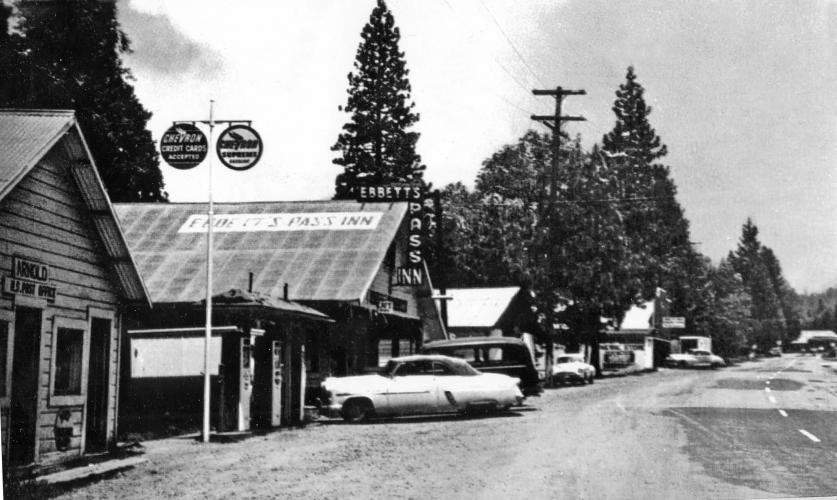Arnold

The land that now encompasses Arnold was first taken up by the Willis Dunbar family of Murphys, who had an 880-acre ranch that provided meat, vegetables, timothy hay, potatoes, and fruit (primarily apples) to nearby resorts and lower elevations from the late nineteenth century into the twentieth. The Dunbars also had a sawmill, which supplied their lumberyard in Murphys, and extensive lumber operations in the area (Elliott 1885:96-97; Mace 1993:145).
It was the advent of the automobile, however, that led to the development of Arnold, as more and more families took to the mountains to partake of the clean rivers, lakes, and cool forests. Commercial establishments were developed along the Ebbetts Pass route to serve travelers and tourists alike, providing automobile services, sustenance, and lodging. Arnold was founded on one of these establishments, and received its name from Bob and Bernice Arnold, who began operating a bar, restaurant, and three cabins there in the 1930s. This business became the nucleus for several other commercial enterprises, all catering to the traveler.
The major growth in Arnold, however, developed after the construction of the Blagen mill, built in White Pines in 1939. A modern twentieth century operation, the enterprise was first a family business. The Blagens established a company town, named White Pines, near their mill on what is now White Pines Lake. The company ran two shifts of men, producing a great amount of lumber during World War II, and employed more than one hundred men. During this period the mill was taken over by American Forest Products, but kept the Blagen name. The mill flourished, but then waned in production, leading to its closure in 1962 (Davis 1993:7-8).
Today, due in part to its proximity to the Calaveras Big Trees and the Mt. Reba ski area, Arnold is one of the county’s fastest growing communities and is being developed primarily as an area for second homes and full-time residents.
Refrences
Costello, Julia G., editor. 1988 Historical and Archaeological Research at the Calaveras Big Tree Cottage Area. Report prepared for Calaveras Big Trees Association and California Department of Parks and Recreation.
Davis, David H. 1993 Early Logging in the Sierras, with Special Reference to the Forested Valleys of Calaveras County. Heritage Resource Program, Calaveras Ranger District, Stanislaus National Forest.
Elliott, W. W. 1885 Calaveras County Illustrated and Described. Bicentennial Reprint, 1976, by Valley Publishers, Fresno.
Gudde, Erwin G. 1975 California Gold Camps. University of California Press, Berkeley
Koeppel, Elliot H. 1995 The California Gold Country: Highway 49 Revisited. Malakoff & Co. Publishing.
Mace, O. Henry . 1993 Between the Rivers, A History of Early Calaveras County, California. Cenotto Publications, Jackson, California.
Office of Historic Preservation. 1998 The California Register of Historical Resources, Public Resources Code, Chapter 11.5, implemented January 1, 1998.
Psota, Sunshine, and Judith Marvin. 2001 Historic Resource Evaluation Report of Three Roads Along State Highway 4 Between Camp Connell and Ganns, Calaveras County, California. Anthropological Studies Center, Sonoma State University Academic Foundation.
Storer, Tracy I. and Robert L. Usinger. 1963 Sierra Nevada Natural History. University of California Press, Berkeley.
